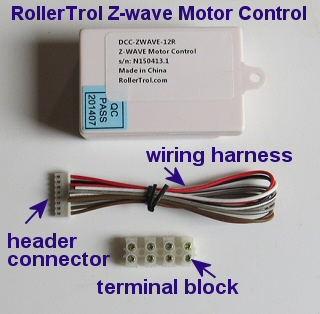
FAQ: Can I use a relay module to control motorized blinds and shades?
Our ZWAVE® shade and blind motor controller (DCC-ZWAVE-12R) can be also be used to activate our radio remote control shade and blind motors using our surface mount radio wall switches, and other interfaces.
The advantage of this configuration is that you can still use our hand held remotes and our very popular wireless motors with built-in batteries. Some models last up to a year without a re-charge (with daily use).
In the previous article in this series (part 2), we examined the ZWAVE relay module that can act as a trigger to control various devices like our window and skylight openers, using our wired wall switch interface. In this third article we will show you how you can connect it to an interface switch to control our radio controlled shade and blind motors.
You can use any Z WAVE hub, such as Razberry Pi, Staples Connect, Fibaro, Wink, SmartThings, Vera, Homeseer, Syslink, Zipr, Xuan, Xuan, Homelive, Isis, Nexia, etc.
Z-Wave Control of Blind and Shade Motors (radio version)
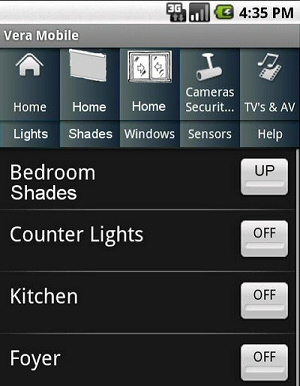 ZWAVE home automation systems invariably include an app or browser access to your various automated devices, including blinds and shades.
ZWAVE home automation systems invariably include an app or browser access to your various automated devices, including blinds and shades.
We can pretty well guarantee you that once you have been operating your window shades by remote control, you'll never want to go back!
The advantage of our radio motors is that you can still use our inexpensive remote controls to control your shades too.
If you retire and forget to put your phone on your night table, it doesn't matter because you can control your wireless bedroom blind motors with an inexpensive wireless wall switch mounted conveniently on your headboard, or wherever you like. If you take your phone to bed, you can use that too.
The ZWAVE control module can be interfaced with our special input/output wall switch interface, with the wiring concealed, in a very similar manner as the wired switch we saw in part 2. In fact we will use almost the same schematics and pictures that you saw in the previous article.
ZWAVE Radio Motor Interfacing
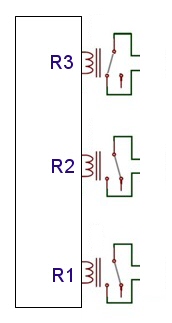 In the previous article ZWAVE article about motor control we examined the basic operation of the z wave trigger module, which is also used in this blind and shade control scenario.
In the previous article ZWAVE article about motor control we examined the basic operation of the z wave trigger module, which is also used in this blind and shade control scenario.
It has 3 single pole, normally open relays (a relay is a switch that can be triggered by electronic circuitry) that are controlled by the zwave signal. In this simple schematic, you can see the 3 relay representations (R1, R2, and R3) clearly.
R1 and R2 are shown in the 'open circuit' position (not activated), while R3 is shown in the 'closed' position where it completes a circuit (activated).
These 3 switch closures trigger the radio wall switch, which in turn transmits a VHF radio signal to the designated blind motor(s). You can control an almost unlimited group of shades simultaneously with this system.
Our customers will often have one of our multi-channel hand held remotes in the room, which will provide individual shade control, when desired, while the zwave unit provides group control.
ZWAVE Schematic for Radio Motor Interfacing
In the diagram below, we have replaced the wired wall switch and window opener with the radio wall switch input output (I/O) module and a tubular shade motor. There is no separate header on the radio wall switch, it is wired directly to the terminal block. It then sends a signal to the radio receiver inside the motor, with the appropriate commands for open/close/stop.
As before, the 3 solid color wires from the bottom side of each relay connect together to form a common ground. When the relays close, the circuit to ground is closed, activating the open/close/stop switches via the cable.
The ZWAVE relays are actually connected in parallel with the push button switches on the radio wall switch, and they do exactly the same thing as if you had pressed one of the switch buttons - close the circuit to ground.
This action activates a transistor circuit, which in turn transmits the radio control signal to the motor. The 433 MHz VHF signal is a relatively low frequency signal, which allows it to pass through walls very easily, reaching any part of a typical home (in most cases).
Note that there is no power connection to the radio wall switch, it operates on an internal button battery that lasts for years. There is also no wiring to the motor; if it is a battery motor it does not require any wiring at all, and if it's a standard radio motor it will draw power from a local power supply plugged into AC somewhere.
We have just included the schematic in case you are interested in how it works, but If you're in a "just want it to work" mood, you can simply follow the discussion and pictures further down on this page ...
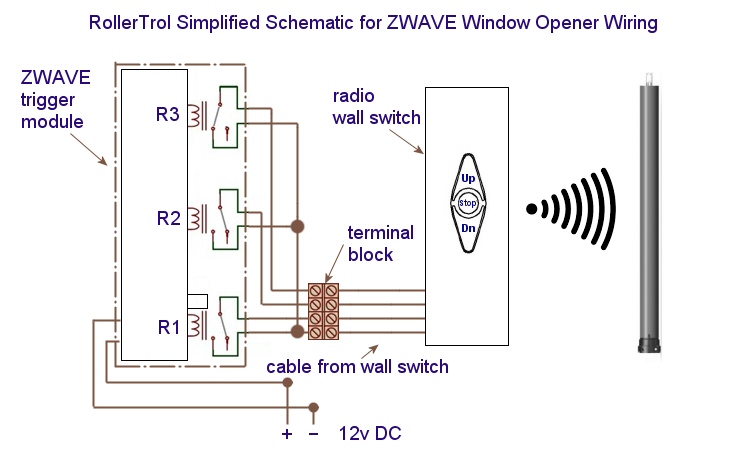
Z-Wave Motor Control System for Window Openers: Wiring Picture
Power: The red and black ZWAVE module wires are for power (red: +12v and black: ground). Note that in the picture there is not a parallel set of wires for powering the radio wall switch as it operates on an internal button battery (for years with daily use). The current draw of the ZWAVE module is quite low (~25 ma).
The radio controlled blind motor is often a self powered motor with a built-in battery (and solar option), or it may be externally powered by an AC power supply located nearby the shade or blind.
Here is the color coding of the 6 ZWAVE relay wires connected to the radio wall switch cable:
| ZWAVE Trigger Module Cable | Radio Wall Switch Cable |
|---|---|
| Relay 1 (open) | |
| solid white | solid green (common ground) |
| white with black stripe | green/white striped |
| Relay 2 (close) | |
| solid gray | solid green (common ground) |
| gray with black stripe | solid orange |
| Relay 3 (stop) | |
| solid brown | solid green (common ground) |
| brown with red stripe | orange/white striped |
Here is a picture of the wiring, and we have shown a 12v AC power supply as the power source, but it could just as easily be a 12v battery with a solar or AC powered trickle charger.
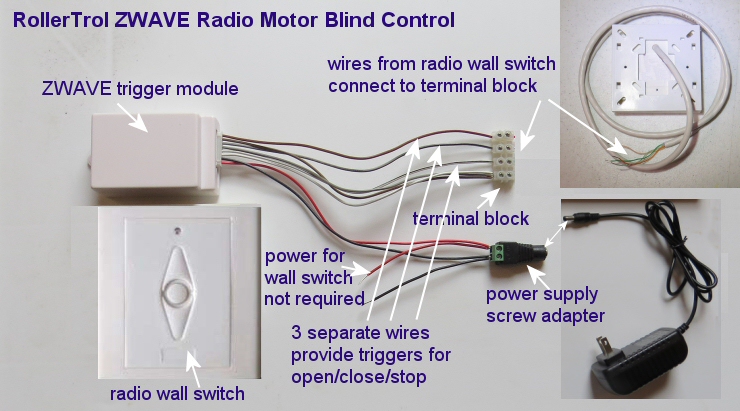
This above is essentially what is in the ZWAVE roller blind motor kits in the kit section of our online store (click to open in new window).
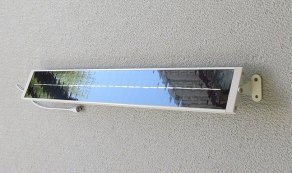 We also have 'in window' solar power options for our battery motors, as shown in the picture at right. They are specially designed elongated units for window sills that have a low profile. Many customers have reported that they have never had to charge their battery motors, even with daily use.
We also have 'in window' solar power options for our battery motors, as shown in the picture at right. They are specially designed elongated units for window sills that have a low profile. Many customers have reported that they have never had to charge their battery motors, even with daily use.
This system can control a group of window blind motors, consisting of many window shades triggered by the same ZWAVE controller. The radio wall switch also functions as usual, and the hand held room remotes will also still work normally.
In the next instalment, we'll show you how to set up the ZWAVE trigger module in your ZWAVE home automation system, using Vera as an example. The configuration process in other ZWAVE automation hubs will be very similar because zwave is a standardized mesh protocol.
We sincerely hope you enjoy using these advanced motors; if you have any questions, please feel free to contact us at any time!

 Shopping Cart Home - Start Here
Shopping Cart Home - Start Here Remote Controls for Radio Equipped Motors
Remote Controls for Radio Equipped Motors DIY Starter Kits for Window Shades
DIY Starter Kits for Window Shades DIY Starter Kits for Window Openers
DIY Starter Kits for Window Openers ZWAVE Blind & Shade Controllers
ZWAVE Blind & Shade Controllers How To Choose the Right Blind & Shade Motor
How To Choose the Right Blind & Shade Motor Select tubular Motor (Comparison table)
Select tubular Motor (Comparison table) Choose RollerTrol Battery & Solar Motors
Choose RollerTrol Battery & Solar Motors DIY Roller Blind Motors - FAQ
DIY Roller Blind Motors - FAQ How To Insert Blind Motors & Attach Brackets
How To Insert Blind Motors & Attach Brackets Calculate your Blind or Shade fabric Weight
Calculate your Blind or Shade fabric Weight Select Tube Size for Blind Motor
Select Tube Size for Blind Motor How to Insert Blind Motors Into Tube
How to Insert Blind Motors Into Tube How to Insert Blind Motors Into Tube with Adapters
How to Insert Blind Motors Into Tube with Adapters Attach Mounting Brackets - Standard + Mini Series
Attach Mounting Brackets - Standard + Mini Series Attach Mounting Brackets - MAXI Blind Series
Attach Mounting Brackets - MAXI Blind Series How To Set Up Radio Equipped Blind & Shade Motors
How To Set Up Radio Equipped Blind & Shade Motors Series P Radio Remote Control Motors
Series P Radio Remote Control Motors Series G Radio Remote Control Motors
Series G Radio Remote Control Motors Series R Radio Remote Control Motors
Series R Radio Remote Control Motors BroadLink RF/IR Hub System for Motors
BroadLink RF/IR Hub System for Motors How To Set Up Window/Skylight Openers
How To Set Up Window/Skylight Openers Introduction: Window & Skylight (K Series)
Introduction: Window & Skylight (K Series) BroadLink RF/IR Hub System for Motors
BroadLink RF/IR Hub System for Motors Z-Wave Interfacing for Shade & Opener Motors
Z-Wave Interfacing for Shade & Opener Motors Wired Wall Switch Control of Window Openers
Wired Wall Switch Control of Window Openers How To Use Alexa With Our Motors & Window Openers
How To Use Alexa With Our Motors & Window Openers How To Use BroadLink Phone App Hub With Our Motors
How To Use BroadLink Phone App Hub With Our Motors How To Set Up ShadeSlider Skylight or Bottom-Up Blind
How To Set Up ShadeSlider Skylight or Bottom-Up Blind How To Retrofit RV, Boat and Motorhome Blinds
How To Retrofit RV, Boat and Motorhome Blinds How To Set Up Non-Radio Motors
How To Set Up Non-Radio Motors Operation & Travel Limits of Non-Radio Motors
Operation & Travel Limits of Non-Radio Motors Make a Simple DC Motor Reversing Switch
Make a Simple DC Motor Reversing Switch How To Set Up ZWAVE Control
How To Set Up ZWAVE Control ZWAVE Controller for G Series Radio motors
ZWAVE Controller for G Series Radio motors ZWAVE Door/Window Opening Detection
ZWAVE Door/Window Opening Detection ZWAVE Motion Detector with Temperature Sensing
ZWAVE Motion Detector with Temperature Sensing Motorized Window Blinds & Shades
Motorized Window Blinds & Shades Motorized Dual Window Shade
Motorized Dual Window Shade Make Motorized Blackout Blinds
Make Motorized Blackout Blinds Phone-Tablet-PC Control for Motorized Blinds
Phone-Tablet-PC Control for Motorized Blinds Mini Motor for Existing Shade Retrofit
Mini Motor for Existing Shade Retrofit Roman Shade Retrofit
Roman Shade Retrofit Make a Motorized Window Opener
Make a Motorized Window Opener Blind & Shade Motors for RV & Boats
Blind & Shade Motors for RV & Boats Make Your Own Projector Screen
Make Your Own Projector Screen Curtain Closer: Ultimate Home Theater
Curtain Closer: Ultimate Home Theater Wireless Battery Operated Drapery Motor Kit
Wireless Battery Operated Drapery Motor Kit Make a Motorized Bottom-Up Shade
Make a Motorized Bottom-Up Shade Make a Motorized Skylight Opener
Make a Motorized Skylight Opener BroadLink RF/IR Hub System for Motors
BroadLink RF/IR Hub System for Motors Why Buy From US?
Why Buy From US? Background & Mission Statement
Background & Mission Statement Customer DIY Testimonials
Customer DIY Testimonials Site Map - Search All Pages
Site Map - Search All Pages Why Buy From US?
Why Buy From US? RollerTrol Users Forum
RollerTrol Users Forum Contact Page
Contact Page